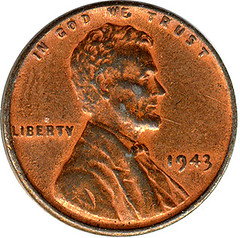
PREV ARTICLE
NEXT ARTICLE
FULL ISSUE
PREV FULL ISSUE
1943 "COPPER" CENT IS A MAGICIAN'S PIECE
Last week Howard Daniel forwarded an unusual auction lot which appeared to be a planed-down 1943 steel cent with a copper plated obverse. I speculated that it was a magician's piece. The verdict from readers is unanimous - yep, it's a magician's piece.
-Editor


Ron Benice writes: The hollowed-out 1943 "copper" cent with steel lining is a magician's piece. A dime fits into the hollowed out reverse. The magician, with a palmed magnet, passes his hand over the "penny" and turns it into a dime. I have no explanation of how the cataloger saw the wheat ears on the reverse. Tom DeLorey writes: The 1943 cent obverse shell is indeed part of a magician's token. I would surmise that the matching piece had a small, thin magnet glued to it or embedded in it, which would attach itself to the steel shell until the magician performed his sleight of hand. The copper plating was just showmanship, lest the natural grey color of the steel cent make the viewer of the trick suspicious. Dick Doty of the National Numismatic Collection at the Smithsonian writes: It definitely was a magician's token. The idea was to change a cent into a dime. The dime nestled underneath the hollowed-out cent. You made a pass over it with your hand (with an alnico magnet hidden between two of your fingers), and shazam! a cent became a dime. I had one myself, age twelve or so, but it had a thin wafer of steel inside, because it had started out as an ordinary bronze cent. A copper-plated ‘steelie' would've worked better. I eventually planed down a second cent so that it would fit inside the first, and I then launched my two-headed penny into commerce. For all I know, it's still out there, somewhere…
Dick Johnson submitted the following story about his own experience with a coin like this.
-Editor
The copperplated 1943 cent illustrated in last week's E-Sylum was indeed a magician's piece. The date is a clue to the trick. I have had one of these in my collection since the late 1940s, purchased at a magic shop in Washington DC (when I was stationed there in the military service). It consisted of a small round wooden red box. You open the box, place a penny inside, replace the lid, then have someone in the audience tap the lid. If you are right handed you hold the box in your left hand and lift the lid with your right hand. In place of the cent coin their now exists a dime. You hand the dime around to everyone's amazement and assurance it is a genuine dime. According to the instructions with the box you are supposed to pull some change out of your pocket and select the cent. I could never master that part. The cent was a prop. The reverse was machined out so it would fit over a dime. I couldn't keep the dime inside the cent shell inside my pocket with the other coins. So I had to pull out the prepared cent alone. Question: Have you figured out yet why it should be a 1943 cent? Answer: There is a tiny magnet it the lid of the box. Immediately when you replace the lid the cent shell is attracted to the lid. It is already stuck there before you have someone tap the lid. That part is just show business! Question: Why should you lift the lid with your right hand? Answer: You palm the cent shell by dragging your fingers across shell to hide it in your palm. That part's easy since everyone is looking at the dime, not what you are doing with your hand. In my box there is a tiny circle of green felt on both the bottom and lid. That hides the magnet in the lid. You can even pass the box around to your audience afterwards for them to examine. Now my box and prepared cent was made before 1943 (it had an earlier dated cent). It has an iron disc pasted inside the shell. That provided enough attraction to the hidden magnet to stick the shell to the lid. The U.S. Treasury made this trick easier by making zinc-coated steel cents in 1943. Trouble is you have to copperplate the 1943 cent first.
To read the earlier E-Sylum article, see:
QUERY: AN ODD 1943 COPPER CENT
(www.coinbooks.org/esylum_v13n40a13.html)
The Numismatic Bibliomania Society is a non-profit organization promoting numismatic literature. See our web site at coinbooks.org. To submit items for publication in The E-Sylum, write to the Editor at this address: whomren@gmail.com To subscribe go to: https://my.binhost.com/lists/listinfo/esylum All Rights Reserved. NBS Home Page Contact the NBS webmaster 
|